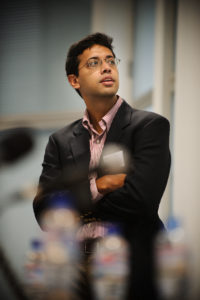
“Migration and the Labor Market Impact of COVID-19”
Mushfiq Mobarak, Yale University
In this talk, Ahmed Mushfiq Mobarak will present the findings from a series of recent studies related to the consequences of COVID-19. The studies analyze the impact of the pandemic on outcomes such as employment, income, food security, including on vulnerable groups such as refugees and migration-dependent households. They also assess attitudes toward COVID-19 vaccination and interventions to promote mask use. The findings have important policy implications on providing emergency support while reforming social protection programs and creating income-generating opportunities to build the resilience of poor households. They will also inform the global effort to promote preventive health behavior and vaccine uptake.
Paper 1: “Falling living standards during the COVID-19 crisis: Quantitative evidence from nine developing countries”
Abstract
Despite numerous journalistic accounts, systematic quantitative evidence on economic conditions during the ongoing COVID-19 pandemic remains scarce for most low- and middle-income countries, partly due to limitations of official economic statistics in environments with large informal sectors and subsistence agriculture. We assemble evidence from over 30,000 respondents in 16 original household surveys from nine countries in Africa (Burkina Faso, Ghana, Kenya, Rwanda, Sierra Leone), Asia (Bangladesh, Nepal, Philippines), and Latin America (Colombia). We document declines in employment and income in all settings beginning March 2020. The share of households experiencing an income drop ranges from 8 to 87% (median, 68%). Household coping strategies and government assistance were insufficient to sustain precrisis living standards, resulting in widespread food insecurity and dire economic conditions even 3 months into the crisis. We discuss promising policy responses and speculate about the risk of persistent adverse effects, especially among children and other vulnerable groups. This paper may be accessed here.
Paper 2: “Migration and the Labor Market Impacts of COVID-19”
Abstract
We report the excess economic vulnerabilities of migration-dependent households during the COVID-19 pandemic using detailed microdata from Bangladesh and Nepal. Leveraging experimental and observa tional variation in prior migration status, we observe 25% greater declines in earnings and fourfold greater prevalence of food insecurity among migrant households since April 2020. Causes evident in the data include lower mobility, less remittance income, and greater health risk and stigma regarding migrants car rying COVID. We document the global scope of this problem by compiling a large set of secondary data to show that labor migration is extremely prevalent in less developed countries, and that the causal economic return to such migration is large. We conclude with suggestions for policy to alleviate the challenges faced by migrants during the pandemic. New mobility restrictions imposed to limit contagion may lead the vulnerabilities to persist for a prolonged period, and this population requires special policy attention.
Paper 3: “Community-Wide Mask Promotion: A Cluster-Randomized Trial in Rural Bangladesh”
Abstract
Background: A growing body of scientific evidence suggests that face masks can slow the
spread of COVID-19 and save lives.
Methods: We conducted a cluster-randomized trial of community-level mask promotion in
rural Bangladesh involving 341,830 adults in 600 villages. Villages were paired and one in
each pair was randomly assigned to intervention or control. In intervention villages, with the
active support of local leaders, we distributed masks (surgical or cloth) to every household and
employed various interventions to promote mask use at mosques, markets, and other public
places multiple times per week. There were no intervention activities in the control villages.
The objective was to assess the degree to which the intervention and cross-randomizations
could increase proper (covering nose and mouth) wearing of face masks. This analysis is part
of larger study evaluating the effect of mask-wearing on transmission of SARS-CoV-2. In this
paper the primary outcome was the prevalence of proper mask-wearing. It was not possible to
blind participants or surveillance staff to the intervention.
Results: There were 64,937 households in the intervention group and 64,183 households in
the control group; study recruitment has ended. In the control group, proper mask-wearing
is practiced by 13% of those observed. Our intervention increased proper mask-wearing by
28.6 percentage points (95% CI: 26.1%-31.1%) over the 2-10 week length of the intervention.
Physical distancing, measured as the fraction of individuals at least one arm’s length apart,
also increased by 6 percentage points (95% CI: 4.9%-7.6%). Mask type (surgical or cloth),
text reminders, public signage commitments, monetary or non-monetary incentives, altruistic
messaging or verbal commitments had no additional effect on people’s propensity to wear
masks. Blue surgical masks were more likely to be worn than green, and purple cloth masks
were more likely to be worn than red. We observe larger increases in mask-wearing among
men and in villages where mask-wearing was initially low. No adverse events were reported
during the study period.
Conclusions: Our intervention demonstrates a scalable and cost-effective method to promote
mask adoption and save lives. Our cross-randomizations suggest this increase can be achieved
without incentives that require costly monitoring, that aesthetic design choices and colors can
influence mask-wearing, and that surgical masks with greater filtration efficiency can be a
cost-effective alternative to cloth masks (1/3 the cost) and equally likely to be worn. Implementing
these interventions – including distribution of free masks, information campaign, reminders,
encouragement – costs $2.30-$3.75 per villager, or between $8 and $13 per person adopting
a mask. Combined with existing estimates of the efficacy of masks in preventing COVID-19
deaths, this implies that the intervention cost $28,000-$66,000 per life saved. Beyond reducing
the transmission of COVID-19, mask distribution is likely to be a cost-effective strategy to
prevent future respiratory disease outbreaks.
Biography: Ahmed Mushfiq Mobarak is a Professor of Economics at Yale University with concurrent appointments in the School of Management and in the Department of Economics. Mobarak is the founder and faculty director of the Yale Research Initiative on Innovation and Scale (Y-RISE). He holds other appointments at Innovations for Poverty Action, the Jameel Poverty Action Lab (J-PAL) at MIT, the International Growth Centre (IGC) at LSE.
A recording of Dr. Mobarak’s presentation may be accessed here.



